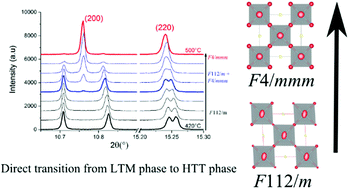Structure and reactivity with oxygen of Pr2NiO4+δ: an in situ synchrotron X-ray powder diffraction study†
Abstract
The promising SOFC cathode material Pr2NiO4.22 has been studied in situ under a pure oxygen atmosphere from 25 to 950 °C by high resolution synchrotron X-ray powder diffraction. At room temperature (RT) δ = 0.22(1), the average crystal structure turns out to be monoclinic. The subtle monoclinic distortion (γ = 90.066(1)° at RT), retained up to 460 °C, is interpreted in terms of specific tilt schemes of the NiO6 octahedra. It is also shown that Pr2NiO4.22 is incommensurately structurally modulated already at room temperature, in the same manner as the homologous cobaltate La2CoO4.14. The phase transition to the High Temperature Tetragonal (HTT) phase was completed at 480 °C without any evidence for the Low Temperature Orthorhombic (LTO) phase allowing clarifying the phase diagram of this K2NiF4-type ternary oxide. Moreover, it turns out that above 800 °C, the HTT phase transforms reversibly into two coexisting isomorphous tetragonal phases. The incommensurate modulation subsists up to 950 °C, although modified concomitantly with the two abovementioned phase transformations. In addition, the role of kinetics on the decomposition process is highlighted through thermo-gravimetric analyses.


 Please wait while we load your content...
Please wait while we load your content...